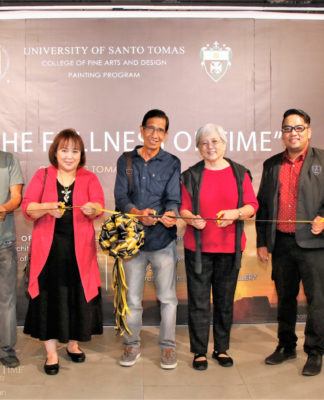November 14, 2015, 7:35p.m. – THOMASIAN researches on a shrimp virus, a medical instrument for pelvic floor diseases, and a more efficient building material bagged awards in a convention hosted by the Department of Science and Technology (DOST) last Sept. 28 to 30 at the Technological Institute of the Philippines.
The DOST-Regional Invention Contests and Exhibits (RICE) gave an award to 1968 architecture alumnus Eduardo Urcia for his economic construction material for walls, flooring and roof boards that reduce noise and serve as heat insulation.
Mary Beth Maningas of the College of Science won first prize in the DOST-RICE for her research on the White Spot Syndrome Virus (WSSV), her fourth major award this year.
The WSSV is an infection in shrimps that can lead to economic losses in the shrimp industry.
The professor and her team from the Research Center for Natural and Applied Sciences devised diagnostic kits for the detection of WSSV, which they plan to distribute to local communities after tests. Pilot-testing of the kits is being funded by the DOST.
The kits, to be distributed to 18 shrimp farms, were built using machines by the Faculty of Engineering, Maningas said in an email to the Varsitarian.
Maningas earlier won the outstanding research paper award during the National Awards for Science and Technology, and the outstanding research and development award for applied research during the National Science and Technology Week.
Maningas and her team are studying genes with therapeutic potential using RNAi (RNA interference) technology, which can be utilized to mitigate WSSV infection. “We are also exploring the utilization of waste materials like calamansi peel, mango peel, pineapple peel, etc., as possible sources of immunostimulants or feed additives for the Aquaculture Industry,” Maningas added.
A more accurate pelvic model
Dr. Maria Teresa Luna of the Faculty of Medicine and Surgery meanwhile built a new pelvic scale model to aid in the demonstration of pelvic organ prolapse, a type of pelvic floor disorder referring to drooping organs in the pelvic area. Her work won third place in the DOST-RICE Likha category for the National Capital Region.
Luna spearheaded a workshop on a scoring system for pelvic organ prolapse during the International Urogynecological Association Exchange Program held in Manila in 2010. The system, consisting of an inverted “Santa Claus hat” model, was designed to describe, quantify and stage pelvic support.
Obstetric practitioners used the model to demonstrate pelvic disorders, but it was found to be inaccurate. This prompted Luna to construct a more “precise” pelvic model.
“I thought that it would be easier for the participants and beneficiaries to understand and for us, (obstetric practitioners), to demonstrate, if we had a pelvic model (in lieu of a real person),” Luna said in an e-mail interview to the Varsitarian.
Luna, Maningas and 15 others are qualified for the Presidential Awards of the 2016 National Invention Contest and Exhibit (NICE), which honor exemplary inventions and research in the country. Mia Rosienna P. Mallari and Julius Roman F. Tolop, with reports from Clarence I. Hormachuelos
















